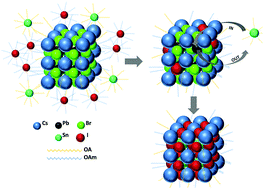An anion-driven Sn2+ exchange reaction in CsPbBr3 nanocrystals towards tunable and high photoluminescence†
Abstract
Fast and efficient ion-exchange reactions endow CsPbX3 nanocrystals (NCs) with superior photoluminescence (PL) properties. In this study, SnX2 (X = I, Cl) was used as a Sn precursor to conduct the cation exchange reaction, which was promoted by anion exchange between the parent CsPbBr3 NCs and the guest X in SnX2. The anion-driven cation exchange reaction occurred efficiently (10 min). CsSnI3 NCs were created by ion-exchange reactions between CsPbBr3 NCs and the SnI2 precursor. The CsSnI3 NCs retained the initial morphology of CsPbBr3 NCs and revealed a high PL efficiency (59%) and prolonged PL lifetime. In contrast, the exchange reaction of Sn2+ ions in CsPbBr3 NCs did not occur in a short time using SnBr2 as a precursor. After the cation exchange reaction, the 4f peaks of Pb ions in X-ray photoelectron spectroscopy spectra shifted to low binding energies as compared to those of the parent CsPbX3 NCs. This is ascribed to the increase in the number of Pb–oleate (Pb–OA) species. Contrary to the hot-injection method used to synthesize CsSnI3 NCs, the kinetically controlled ion exchange reactions lead to the synthesis of CsSnI3 NCs with a high structural stability. Thus, an anion-exchange-promoted cation exchange reaction is a particularly efficient versatile tool to dope Sn2+ into CsPbX3 NCs.



 Please wait while we load your content...
Please wait while we load your content...